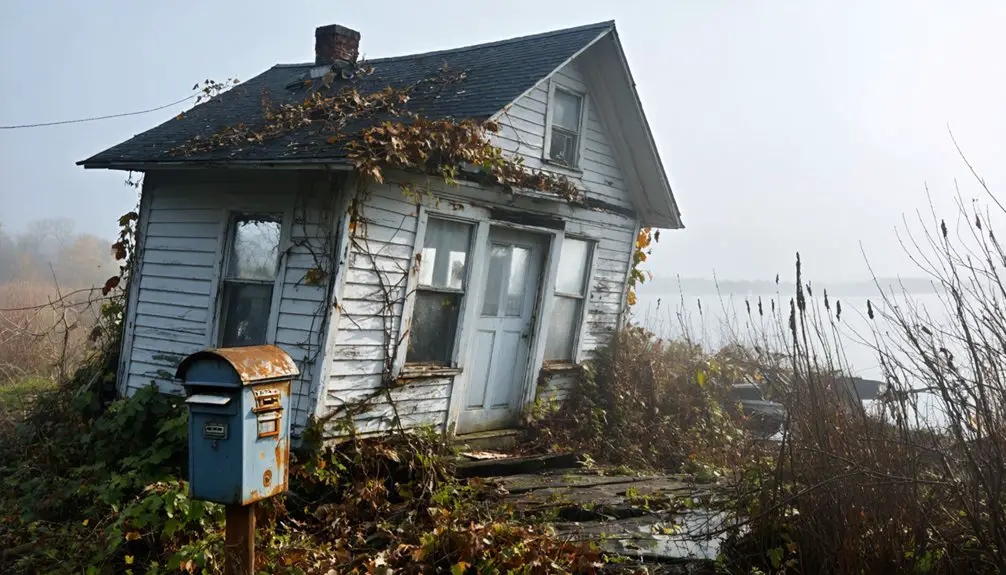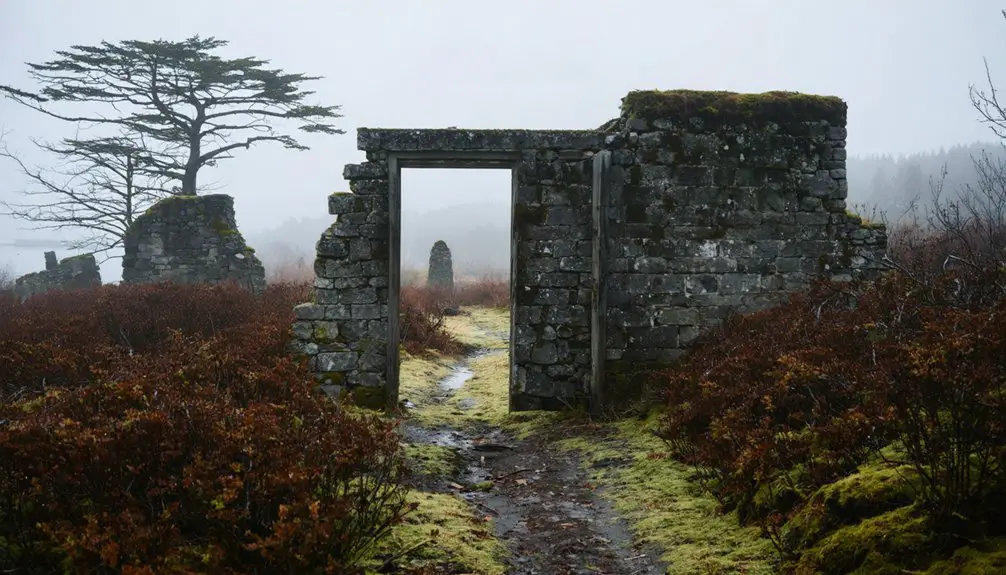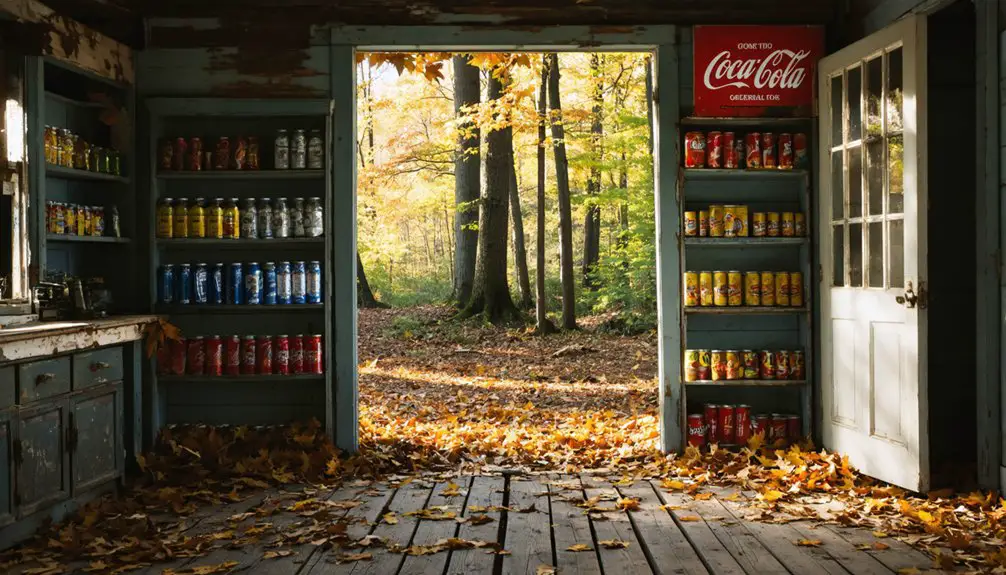You’ll find Perkins Township, a haunting ghost town on Maine’s Swan Island, in Sagadahoc County. First settled in 1730, it thrived as an independent township from 1847 to the 1930s with nearly 100 residents engaged in shipbuilding, farming, and fishing. After economic hardships and river pollution forced families to leave, the state acquired the land. Today, five historic homes and countless cellar holes reveal stories of this once-vibrant maritime community.
Key Takeaways
- Perkins Township became a ghost town after economic challenges in the 1930s led to community migration and eventual abandonment.
- The last residents departed after the State of Maine acquired island properties and ferry service ended.
- Maine’s Department of Inland Fisheries and Wildlife manages the abandoned township as the Steve Powell Wildlife Management Area.
- Five historic houses remain standing, preserving architectural heritage from Colonial, Federal, and Late Victorian periods.
- Pollution in the Kennebec River devastated fishing industries, while the shutdown of shipbuilding weakened the township’s economic foundation.
Early Settlement and Colonial Origins
While indigenous peoples had long called Swan Island home, European colonization of this strategic Kennebec River location began in earnest during the early 18th century. The Abenaki people of the Kennebec tribe had established deep connections to the land, using sites like Carrying Place and leaving behind burial grounds that testified to their indigenous heritage. The name Swan Island likely originated from the Abenaki word Swango, meaning Island of Eagles.
You’ll find the first European contact occurred in 1607 with the Popham Colony, followed by Captain John Smith’s visit in 1614.
By 1730, the first European homesteader arrived amid colonial conflicts with native inhabitants. Massachusetts soon offered land grants requiring Protestant families to build homes, churches, and schools.
Settlers from coastal Maine towns like Deer Isle and Mount Desert flocked to the island, drawn by promises of free land deeds after seven years of residence. The early residents primarily focused on farming and fishing to sustain their growing community.
Township Formation and Incorporation
After years of mounting tensions over high taxation under Dresden’s jurisdiction, Perkins Township gained its independence through official incorporation in 1847. You’ll find that this liberation was made possible through the financial backing of Thomas Handasyd Perkins, a wealthy Boston merchant and prominent summer resident, for whom the township was named.
The newly formed township encompassed Swan Island and Little Swan Island, establishing its own town governance with elected officials and crucial community infrastructure. Before European settlement, the area was home to an estimated 1500 indigenous braves who lived under the leadership of Chief Kennebis. The island’s development included a network of small connecting roads that linked various sections of the community.
You’d have seen the construction of a schoolhouse, maintenance of a cemetery, and other essential facilities reflecting organized town life. When Sagadahoc County formed in 1854, Perkins Township transferred from Lincoln County’s jurisdiction, marking another significant change in its administrative boundaries.
Life in 19th Century Perkins
During the mid-19th century, Perkins Township thrived as a vibrant community of nearly 100 residents who built their lives around farming, fishing, and maritime trades.
Your daily routines would’ve centered on tending crops, harvesting ice from the Kennebec River, or working at one of the island’s three major ice houses.
You’d have sent your children to the local schoolhouse, which doubled as a venue for community events and town meetings.
The Federal-style Tubbs-Reed House and other prominent homes, built by retired sea captains and Revolutionary War veterans, stood as symbols of the island’s prosperity.
From your home, you might’ve watched ships navigate the Kennebec’s channels or joined neighbors for social gatherings in homes and schools, where the rhythms of agrarian life shaped your seasonal activities.
Economic Activities and Industries
You’ll find that Perkins Township once thrived through several interconnected industries, including the construction of at least seven ocean-going vessels and the operation of three major ice houses along the Kennebec River.
The summer residents became attracted to the area, with notable figures like Thomas Handasyd Perkins helping fund the township’s incorporation.
The island’s maritime economy integrated shipbuilding, ice harvesting, and fishing until technological changes and river pollution disrupted these trades in the early 1900s.
Nearly 100 residents sustained themselves through farming across 400 acres of fields while supplementing their income through seasonal work in lumber, ice cutting, and maritime activities.
Shipbuilding and Maritime Trade
At its economic height in the mid-1800s, Perkins Township’s Swan Island emerged as a significant shipbuilding center, producing seven sea-going vessels that served Maine’s thriving maritime trade networks.
You’ll find that local shipwrights employed traditional timber framing and planking techniques, using lumber harvested from the region’s forests.
The island’s shipbuilding industry didn’t stand alone – it powered a vibrant maritime commerce ecosystem including fishing, ice harvesting, and lumber transport. The three ice houses operated on the island during the early 1900s contributed substantially to the maritime economy.
The industry thrived during Maine’s Golden Economic Age of the 1850s, when fishing and shipbuilding drove unprecedented growth.
By 1894, daily steamboat mail runs connected Swan Island to ports like Stonington, Vinalhaven, and Rockland.
The introduction of steam-powered vessels, such as the seiner Novelty in 1882, modernized the local fleet.
This maritime activity helped sustain Perkins Township’s economy until the post-World War I era, when shifting industrial trends and population decline marked the end of the island’s shipbuilding era.
Ice Harvesting Operations
While Maine dominated America’s 19th-century ice trade, Swan Island‘s three major ice houses – Consumer’s, Underwood’s, and Deering’s – played a significant role in the bustling Kennebec River ice harvesting industry.
You’d find these impressive structures along the island’s eastern banks, where workers cut massive ice blocks during winter months. Rufus Page built the first large ice house along the Kennebec in 1826, setting the stage for future operations.
The economic impact was staggering – Maine’s ice trade generated more wealth than California’s gold rush at its peak.
Ice harvesting techniques involved cutting blocks from the frozen Kennebec, then preserving them with sawdust insulation for summer use. The premium crystal blue ice from the Kennebec River was known for its exceptional quality and lack of flaws.
By the 1880s, the river supported about 25,000 workers, harvesting over 1 million pounds of ice.
This prosperous era lasted until the 1920s, when mechanical refrigeration ultimately led to the industry’s decline and contributed to Swan Island’s eventual abandonment.
Farming and Fishing Activities
Throughout Perkins Township’s vibrant history, farming and fishing formed the backbone of Swan Island’s mixed economy, with early settlers cultivating extensive potato fields that yielded up to a thousand bushels annually.
You’d find nearly 100 residents engaged in crop rotation and agricultural pursuits by the mid-1800s, working the island’s fertile soil alongside their maritime activities.
The waters around Swan Island teemed with diverse fish species, supporting traditional harvests of lobster, scallops, shrimp, and shad.
In the late 1980s, the community embraced aquaculture when Mariculture Products established salmon farming operations near Scrag Island and Toothacher Cove. A processing plant in Minturn employed up to twenty islanders, providing both full-time and part-time job opportunities for local residents.
Though the venture closed by 2003, it represented the island’s adaptability in combining traditional fishing practices with modern marine industries.
Historic Buildings and Cultural Legacy
Perched on Swan Island, five historically significant houses stand as enduring symbols to Perkins Township’s rich architectural heritage.
You’ll find a remarkable collection of Colonial, Federal, and Late Victorian styles, including the Gardiner-Dumaresq House – possibly America’s first summer home, built between 1758-1763. The Tubbs-Reed House, constructed by Revolutionary War officer Major Samuel Tubbs, showcases unique Federal period features like rounded corners and a Dutch oven fireplace.
Beyond these architectural treasures, you’ll discover the cultural legacy of a once-thriving community through the Curtis Cemetery, ruins of over 20 cellar holes, and historic pathways that trace the former town layout.
These remnants tell the story of a vibrant settlement that peaked at nearly 100 residents by 1860, reflecting the area’s colonial agrarian roots.
The Path to Abandonment

As the early 20th century unfolded, Perkins Township faced mounting pressures that would seal its fate as a ghost town.
You’ll find that community migration patterns accelerated through the 1930s as traditional industries faltered. The shutdown of local businesses, from shipbuilding to fishing operations, stripped away economic resilience challenges that proved insurmountable.
Environmental changes dealt additional blows, with pollution in the Kennebec River devastating the fishing industry.
The State of Maine’s gradual acquisition of island properties and the loss of ferry service further isolated remaining residents. As taxes from mainland towns mounted and infrastructure crumbled, families had little choice but to relocate.
The transformation from thriving township to abandoned isle was complete when the last residents departed, leaving their homes to nature’s reclamation.
State Management and Wildlife Conservation
Since the 1940s, Maine’s Department of Inland Fisheries and Wildlife has overseen Swan Island’s transformation into the Steve Powell Wildlife Management Area, finalizing its acquisition in 1988.
You’ll find their conservation strategies focus on protecting native wildlife while allowing compatible recreational activities like hiking, fishing, and birdwatching.
The wildlife management approach includes specialized food plots and a dedicated observation tower that lets you view local species without disturbing them. A kids-only trout pond encourages young conservationists, while ten Adirondack shelters and maintained trails provide low-impact access to the island’s natural beauty.
Though federal funding restrictions limit historic preservation efforts, the state successfully balances multiple uses of the land, maintaining the area’s ecological integrity while offering you opportunities for outdoor recreation and environmental education.
Frequently Asked Questions
Can Visitors Stay Overnight on Swan Island Today?
You can stay overnight at Swan’s Island’s Burnt Coat Harbor Light Station in a queen-sized apartment for two. Weekly rentals run June through October, with prices ranging $1210-$1430 plus tax.
What Happened to the Families Who Left Swan Island?
You’ll find Swan Island families primarily relocated to mainland Maine towns like Dresden and Richmond, seeking better economic opportunities after pollution and industry decline turned their home into a ghost town.
Are There Any Dangerous Wildlife Species on the Island?
You’ll find minimal wildlife safety concerns on the island. While white-tailed deer, wild turkeys, and bald eagles inhabit the island ecosystem, there aren’t any dangerous predators or venomous species present.
How Do People Access Swan Island in Modern Times?
You can reach Swan Island via Maine State Ferry Service from Bass Harbor or use the private ferry service. You’ll also find island tours available, or you’re free to kayak there yourself.
Did Any Paranormal Activity Get Reported in the Abandoned Buildings?
Like whispers in empty halls, you’ll find no verified ghost sightings or eerie sounds here. While local folklore hints at hauntings in the abandoned 18th-century homes, there’s no documented paranormal evidence to explore.
References
- https://www.mainepreservation.org/most-endangered-2023-1/2023/10/4/historic-resources-of-swan-island
- https://maineanencyclopedia.com/swan-island/
- https://swanislandmaine.org/history
- https://touringmaineshistory.wordpress.com/2012/03/21/the-territory-of-perkins-maine/
- https://maineboats.com/coastal-adventures/swan-island-jewel-on-the-kennebec
- https://archive.org/download/historyofswansis00smal_0/historyofswansis00smal_0.pdf
- https://www.seekingmyroots.com/members/files/H003997.pdf
- https://si.mainememory.net/page/3259/display.html
- https://www.familysearch.org/en/wiki/Perkins
- https://www.maine.gov/ifw/docs/swan isl tour bk 12.pdf



